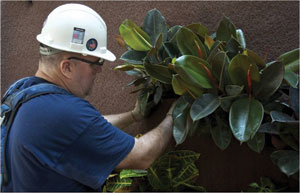Indoor Air Biofilters Deliver Clean Air Naturally
 |
 |
 |
 |
Top two photos courtesy of Nedlaw Living Walls Inc. and bottom two photos courtesy of Sean Corbett, Drexel University |
Construction of the biofilter will typically begin by making sure that the basin is complete and waterproofed. It also requires ductwork or other aspects of the HVAC system to be in place if the biofilter is intended to connect into it. The infrastructure framework is then installed which primarily consists of multiple columns of perforated ductwork that draws the air into the system and channels it upward for distribution. A multi-story system will likely have intermediate manifolds and the whole system needs to be secured to the wall to support itself and the remaining elements.
Installation process of an indoor air biofilter: the basic infrastructure is set in place; the growth/rooting media is secured; plants are placed into the growth media; the final details of the wall are completed.
Next sheets of air permeable growth media are installed over the ductwork infrastructure in two layers and fastened in place. At this point the system is ready to receive plants which first must be removed from any soil so their roots are fully exposed. When ready, the plants are slipped into the growth medium and secured so the roots can both receive circulated water and filter the air.
The plants actually selected for use in the biofilter need to be carefully chosen for their appropriateness and effectiveness. This can include a mix of flowering and foliage varieties but will likely require the input of a specialist to discern the best mix to use for any given location. Some common choices include large leaf plants like philodendron selluom, or ficus elastica which can also add some variegated or deep coloring to the vertical wall of plants. Other small leaf varieties such as ficus benjamina or dazzle and cappella arboricola add full green coloring and a variation in texture. All plants must be able to thrive in controlled indoor environments and allow the beneficial microbes to grow on their exposed roots to perform the biofilter function. It is interesting to note that since these systems are built using natural plants and microbes, it takes advantage of nature's inherent ability to repair itself when it is stressed or damaged. It is this self-rejuvenation that is responsible for keeping outside air “fresh” and the same is true with living plants inside.
CONCLUSION
An indoor air biofilter is an aesthetic plant-scape that cleans air using natural processes to clean and improve the overall indoor environmental air quality in buildings. The soil-free system enables the creation of beautiful, and functional, living works of art that transform otherwise unused vertical surfaces into spaces where people can collect, congregate, relax, and refresh. They contribute to green building and sustainable design by improving the indoor environment, the health and well-being of building occupants, and optimize the use of energy for ventilation. Architects who choose to properly design and specify indoor air biofilters into buildings can provide their clients with all of these benefits while creating dramatic and appealing indoor spaces.
 |
The science behind Nedlaw Living Walls’ indoor air biofilter had its start back in 1994 at the Controlled Environment Systems research facility at the University of Guelph in Ontario, Canada. Early research was funded by the Ontario Center of Excellence (OCE) and by the European and Canadian Space agencies. The group gained worldwide recognition for their use of biological systems to improve indoor air quality. www.naturaire.com |








